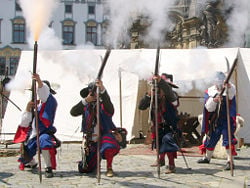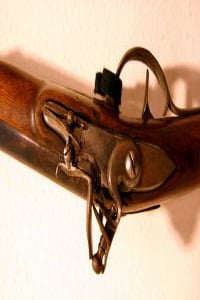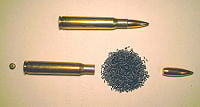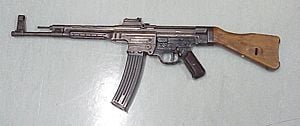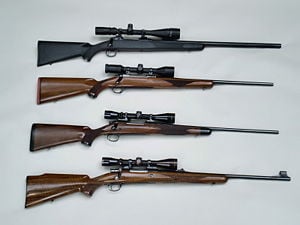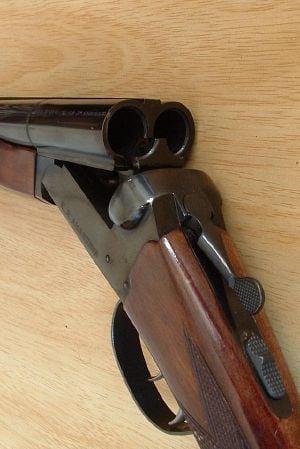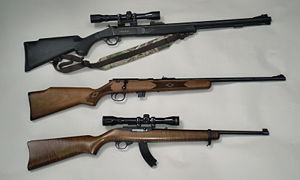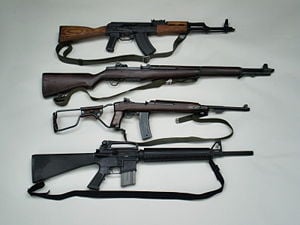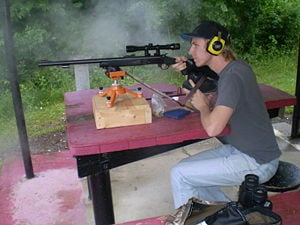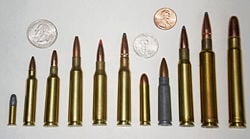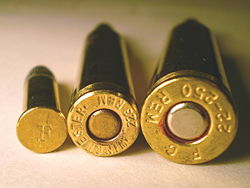Rifle
A rifle is a firearm with a barrel that has a helical groove or pattern of grooves ("rifling") cut into the barrel walls. This pattern is known as "rifling," and produces raised areas, or "lands," which make contact with the projectile (usually a bullet), imparting spin around an axis corresponding to the center line of the projectile. When the projectile leaves the barrel, the conservation of angular momentum, as in a spinning gyroscope, improves accuracy and range. The word "rifle" originally referred to the grooving, and a rifle was called a "rifled gun." Rifles are used in warfare, competitive target shooting, hunting, and sport shooting. Artillery pieces used in warfare, including 12-inch or larger naval guns and the like, also usually have rifled barrels. This article will be confined to shoulder-fired rifles, not artillery pieces.
Typically, a bullet is propelled by the contained deflagration (rapid burning) of gunpowder; this was originally black powder, later Cordite, and now smokeless powder, usually made of nitrocellulose or a combination of nitrocellulose and nitroglycerin. Other means, such as compressed air, or CO2 from small CO2 cylinders, are used in air rifles, which are popular for vermin control, hunting small game, casual shooting, and some target competitions.
The development of rifles
Origins
Muskets, the rifle's predecessors, were smooth-bore, large caliber weapons using ball-shaped ammunition fired at relatively low velocity. Due to the high cost and great difficulty of precision manufacturing and the need to load readily from the muzzle, the musket ball was a loose fit in the barrel. Consequently, on firing, the ball bounced off the sides of the barrel when fired and the final direction on leaving the muzzle was unpredictable. In addition, early muskets produced large quantities of smoke and soot, which had to be cleaned from the action and bore of the musket frequently.
Muskets performed sufficiently in early warfare primarily because of the styles of warfare at the time. European soldiers tended to stand in stationary long lines and fire at the opposing forces, which meant that one did not necessarily have to have the bullet going precisely in the direction one wanted in order to hit an opponent.
The origins of rifling are difficult to trace. Archers had long realized that a twist added to the tail feathers of their arrows gave them greater accuracy. According to some reports, the first documented appearance of rifling was in Germany, around 1460, although the precision required for its effective manufacture kept it out of the hands of infantrymen for another three and a half centuries, when it largely replaced the unrifled musket as the primary infantry weapon. The flintlock was developed in the early 1600s, replacing earlier firearm-ignition technologies, such as the matchlock and wheellock mechanisms. Sometime in the eighteenth century, Benjamin Robins, an English mathematician, realized that an extruded bullet would retain the mass and kinetic force of a musket ball, but would slice through the air with much greater ease. It took until about the end of the eighteenth century for the innovations of Robins and others to become dominant.
Around 1725, in Eastern Pennsylvania, gun makers began making a long barreled rifle, usually in .50 caliber. It became known as the Pennsylvania/Kentucky rifle because it was carried to the frontier of America, which at that time was Kentucky. This rifle became extremely important in the American Revolutionary War because it enabled the American patriots to out shoot their British enemies, who had inferior muskets firing round balls.
The British soon became aware of the superiority of the Pennsylvania Rifle. Col. George Hanger, a British officer, became very interested in the American rifle after he witnessed his bugler's horse shot out from under him at a distance, which he measured several times himself, of "full 400 yards." Hanger then learned all he could of the weapon. He wrote:
I have many times asked the American backwoodsman what was the most their best marksmen could do; they have constantly told me that an expert marksman, provided he can draw good & true sight, can hit the head of a man at 200 yards.[1]
During the eighteenth century, breech-loading weapons were designed, which allowed the rifleman to reload while under cover, but defects in manufacturing and the difficulty in forming a reliable gas-tight seal prevented widespread adoption.
Nineteenth century
In the nineteenth century, the muzzle-loading rifle gradually gave way to the breech-loading rifle that used a cartridge consisting of the gunpowder and the bullet, all bound together. The first cartridges were paper. Eventually the cartridge became today's combination of primer, powder, and bullet in a metal casing, usually of brass. The advent of cartridges and breech loading also made possible the adoption and use of repeating rifles, meaning rifles that had a magazine that could be loaded with a number of cartridges, so that all that was necessary for a second shot was to operate the gun mechanism to expel the spent cartridge case and load a fresh one from the magazine into the chamber of the gun. Some early muzzle loading repeaters had been made using the revolver principle, in which a revolving cylinder had chambers each of which was loaded and could be turned so that the load lined up with the barrel and could be fired through the barrel.
By the mid-nineteenth century, manufacturing had advanced sufficiently that the smoothbore musket was replaced, for military use, by a range of rifles—generally single-shot, breech-loading—designed for aimed, discretionary fire by individual soldiers. Until the early twentieth century, rifles tended to be very long—an 1890 Martini-Henry was almost six feet (1.8 m) in length with a fixed bayonet. The demand for more compact weapons for cavalrymen led to the carbine, or shortened rifle.
One important nineteenth century development was the lever action repeater rifle, first of which were the Henry rifles in the late 1850s. It used a .44 caliber rimfire cartridge loaded with black powder, and was decisive in some battles in the Civil War when used by some Union (Northern) soldiers against their Confederate enemies who had only muzzleloaders. Later the Winchester 1866, 1873, 1894, and 1895 rifles appeared, the latter two designed by John Browning, arguably the greatest firearm designer in history. These lever action rifles became very popular and dominated some markets for a time.
During the nineteenth century, multi-shot repeating rifles using lever-action, pump-action, or bolt actions became standard, further increasing the rate of fire and minimizing the fuss involved in loading a firearm. The problem of proper seal creation had been solved with the use of brass cartridge cases, which expanded in an elastic fashion at the point of firing and effectively sealed the breech while the pressure remained high, then relaxed back enough to allow for easy removal.
Bullet design also evolved in the nineteenth century, with the slugs becoming gradually smaller and lighter. By 1910, the standard blunt-nosed bullet had been replaced with the pointed, "spitzer" slug, an innovation that increased range and penetration. Cartridge design evolved from simple paper tubes containing black powder and shot to sealed brass cases with integral primers for ignition, while black powder itself was replaced with cordite, and then other smokeless mixtures, propelling bullets to higher velocities than before.
The increased velocity meant that new problems arrived, and so bullets went from being soft lead to harder lead, then to copper jacketed, in order to better engage the spiraled grooves without "stripping" them, or to come apart too easily in flight or upon encountering the target.
Twentieth century
The carnage of World War I was perhaps the greatest vindication and vilification of the rifle as a military weapon. The advent of massed, rapid firepower and of the machine gun and the rifled artillery piece came about so quickly that they outstripped any ability to develop a way, during the trench warfare of WWI, to attack a trench defended by riflemen and machine gunners. By World War II, however, military thought was turning elsewhere, towards more compact weapons.
As gun mechanisms became smaller, lighter, and more reliable, semi-automatic rifles, including the American M1 Garand, appeared. World War II saw the first mass-fielding of such rifles, which culminated in the development of the German Sturmgewehr 44, the first "assault rifle" and one of the most significant developments of twentieth century small-arms. Today, most military rifles throughout the world are semi-automatic types; the exception being some highly refined bolt action rifles designed for extremely accurate long range shooting—these are often known as sniper rifles.
Types of rifles today
There are numerous types of rifles today, based on the gun mechanism and how it operates. A rifle or shotgun is usually said to have three main parts: The lock (or central mechanism of the gun), the barrel (or barrels) in which the cartridge or shell is fired and out of which the bullet or shot charge is driven by the gunpowder, and the stock. In the past, gunstocks were almost always made of wood, but today they can be made of wood, metal, or various synthetics, or some combination of those. The stock fits against the shoulder of the person firing the gun and provides a means of holding the gun.
Bolt action Rifles
The most common rifle type today in civilian use is the bolt action rifle. In this action type, there is a turning bolt that has lugs that lock into recesses in the receiver part of the rifle, at either the head of the bolt, or (less commonly) the rear of the bolt, or (in the case of .22 rimfire and similar low-power rifles) using the base of the bolt handle. In this type of rifle, the shooter manipulates the bolt handle, turning it up and pulling it back to eject the spent cartridge case.
Bolt action rifles can be either single-shots—meaning that they have no magazine and have to be loaded manually after each firing—or they can have magazines holding one or more fresh cartridges. Magazines for bolt action rifles can be either tubular—in which fresh cartridges are lined up in a tube, usually under the barrel, with the point of one facing the base of the one ahead of it—or box or "clip" type, in which cartridges are put one atop another in a box or clip that is placed under the bolt. After firing, the gun operator grasps the bolt handle, opens the bolt, and pulls it backwards. If it is a magazine rifle and there is a cartridge in the magazine, the bolt then can be pushed forward and turned down, locking it in place and the gun will be ready to fire again. If it is a single shot, the operator must manually put a fresh cartridge into the gun.
Some single shot bolt action rifles have manual cocking, meaning that the cocking piece needs to be pulled back and set manually before the gun can be fired. Such manual cocking often appears on guns designed to be used by young shooters, as this is considered to be an additional safety feature of such guns. So called youth guns are usually single shots, bolt action, and usually made smaller in order to fit the body size of a younger person; they also often require manual cocking.
Probably the greatest designer of turnbolt-type bolt action centerfire rifles was the German Paul Mauser, and Mauser rifles bear his name to this day. His designs culminated in the 1898 Mauser, which was Germany's primary battle weapon through two World Wars. Mauser's rifle designs also serve as the foundation of nearly all subsequent centerfire turnbolt-type bolt action rifle designs to today—they can be thought of as modifications of Mauser's work—including the U.S. made 1903 Springfield, the pattern '13 and '17 Enfields, the Winchester Models 54 and 70 sporting rifles, the Remington models 30, 721 and 700, the Ruger Model 77, the Czech Brno, the Dakota, and numerous others. The U.S. M1903 Springfield was, in fact, so closely copied from Mauser's design that Mauser sued the U.S. government for patent infringement and won the suit, so the U.S. had to pay Mauser an indemnity fee for a license to produce the Springfield.
Bolt action rifles are the most common action type used in hunting, plinking (informal shooting), and target competition, although they are now mostly obsolete for military use except as long-range sniper weapons. They are available in a full range of caliber sizes, from the smallest (such as the .22 short rimfire) to the largest (such as the .50 caliber Browning Machine Gun cartridge or the .700 Holland & Holland Nitro Express). They can also be made to be the most accurate of all rifles.
Break open rifles
A second type of rifle is the break open rifle. These can be either single shots or double rifles (similar to a double barrel shotgun). This gun action-type opens on a hinge pin, with the barrel (and its chamber) opening to the operator. There is a latch in the gun frame that holds the gun closed with the barrel in firing position until the handle of the latch is pushed to the open position.
Break open guns can have either extractors, which lift the shell out of the chamber slightly (about ¼ to ½ inch) so that it can be manually grabbed and removed, or ejectors, which are spring loaded devices that actively eject the cartridge case from the gun when the gun is broken open. Extractors are often made automatic, so that they perform as extractors if the cartridge in the barrel has not been fired, or as ejectors if it has been fired. (This is true of shotguns too; which often have selective automatic ejectors, ejecting the spent case from whichever, or both, of the barrels that have been fired, and performing as an extractor for any unfired cases.)
The single shot break open rifle is quite similar to a break open single shot shotgun. This gun often has an exposed hammer that needs to be manually cocked before the rifle can be fired. The rifle is loaded manually, by breaking open the rifle, removing the spent cartridge case, and inserting a fresh round into the chamber. The rifle is then closed and it is ready to be cocked (if manual cocking is necessary) and fired. A feature of such rifles is that they often have interchangeable barrels, meaning that the shooter can have numerous calibers of rifle on the same gun frame, simply by switching to a barrel of a different caliber.
The second type of break open rifle is the double barrel. In this gun type, there are two barrels fastened together into one unit, and each barrel is loaded separately, so that two shots are available before the gun needs to be reloaded. After the first shot is fired, the second shot is fired when the trigger is pulled again (in single trigger-type double barrels) or when the second trigger is pulled (in double trigger guns).
As with shotguns, there are two different configurations of double barrel rifles: The side by side and the over under. In the side by side, the two barrels are next to each other horizontally, and in the over under one barrel is above the other vertically. Both types have certain advantages. The side by side does not need to open on as large an arc so that both barrels can be loaded or unloaded. The over under presents a narrower sighting plane to the shooter. Most side by side double rifles have double triggers; single triggers are more common on over unders.
Double rifles of either type are the most expensive rifles made. They start at US$5000 or more, and can go up to US$50,000 or $100,000 or even more—a double rifle from top British manufacturers such as Holland & Holland, Purdey, or Boss can go for £90,000 (about US$180,000) or more. Double barrel rifles are often custom made, with a substantial amount of hand labor put into them. They are rare in America, but were commonly used in Europe. They were especially favored in African hunting, usually in heavy calibers, for the largest and most dangerous game. They are often not especially accurate—it takes a great deal of expensive work, called regulation, to get the two barrels to shoot to the same point—but are designed to get off two very quick shots at relatively short distances.
For gun aficionados, double rifles often represent the pinnacle of the gun-making arts.
Still another type of break open gun is known as a drilling. These are almost unknown in America, but are somewhat popular in Europe. A drilling has several barrels, usually three or more, on a single frame, and there is at least one shotgun barrel and at least one rifle barrel in the group. There is a switch on the gun that allows the shooter to choose which will be fired. The point of a drilling is that the shooter has, on one gun frame, a shotgun—typically a double barrel shotgun—and also one or more rifle barrels, so the shooter can use this one gun for several types of hunting at the same time: Small game hunting where a shotgun is appropriate, and then switch to a centerfire rifle if a larger game animal, such as a deer or bear, is found. Drillings are also quite expensive.
Lever action rifles
The lever action rifle was one of the first repeater rifle designs. The most common version is the Winchester Model 1873 and then the Model 1894 (usually known simply as the Model 73 and Model 94 Winchester)—the gun often seen in Western movies. Operating the lever, which is under the butt stock and behind the trigger guard, ejects the spent cartridge casing and loads a fresh cartridge from the magazine into the chamber for firing; it also cocks the firing mechanism for firing. Many lever action rifles have an exposed hammer that can be lowered without firing the round, but then needs to be cocked manually for firing.
Lever action rifles are made in calibers from .22 rimfire to larger, including (for some makes and models) the .30-06 or .45-70, but the largest or most powerful of rifles are usually not made in lever actions—this action type is not strong enough for the heaviest or most powerful cartridges or loads. Some, such as the Winchester 94, are top ejecting, meaning that a telescope sight cannot be mounted directly above the bore. Others, like the Marlin Model 336, are side ejecting.
Many lever action rifles utilize a tubular magazine under the rifle barrel. Since the cartridges are lined up in the magazine with the tip of one facing the base of another, there is a danger in centerfire tubular magazines holding ammunition with sharp-pointed bullets that the point of one might hit the primer of the one ahead of it and set it off, so ammunition with sharp-pointed bullets must not be used in the tubular magazines of lever rifles. (Tubular magazines of .22 rimfire rifles of any type do not have this problem.)
There are lever action rifles with non-tubular magazines, so that problem does not apply to them. One is the Savage Model 99; none of those have tubular magazines. Some had a rotary type box magazine, and others have simple box-type magazines. The Browning Lever Action Rifle (BLR) also has a box-type magazine, and is available in powerful calibers, such as .30-06 and others. The Savage is unlike the others in not having an exposed hammer.
Winchester also made the Model 95 lever action rifle in such powerful calibers as .30-06 Springfield and .405 Winchester. It had a box-type magazine. Later on Winchester also made the Model 88 lever action. It had a box-type magazine, a one-piece streamlined stock and a rotating front-locking bolt like a bolt action rifle. It was an entirely different rifle than the classic Winchester lever actions and was available in .308 Winchester, .284 Winchester, .358 Winchester, and some other calibers.
Probably the most common cartridge ever used in lever action rifles—especially the Winchester Model 94 and Marlin Model 336 ones—is the 30-30 Winchester. The .300 Savage, although it is now near-obsolete and has mostly been supplanted by the better .308 Winchester, in a Savage Model 99 rifle was once a commonly used hunting rifle for deer, black bear, elk, moose and other big game. Some lever action rifles, such as the Winchester 95, have also been used by various armed forces as military weapons.
Pump action rifles
In a pump action rifle (also known as slide action, and sometimes a trombone action), the forestock is manually pulled back and then manually pushed forward to operate the gun mechanism. This action expels the spent case or shell and then takes a fresh cartridge from the magazine and chambers it in the barrel. It also cocks the firing mechanism of the rifle so that it is ready to fire when the trigger is pulled.
Although pump action rifles have been made by various manufacturers, Remington has dominated in this type. Browning also makes a pump rifle, the BPR. Pump-type rifles can have either tubular or box-type (or clip-type) magazines, and have been available in calibers as powerful as the .30-06 and .35 Whelen. Many .22 rimfire rifles in pump action have also been made.
This rifle type is popular in North America, but—for whatever reason—has been almost unknown in Europe, Asia, or Africa. It is the fastest-operating of all the manually operated rifles.
Autoloading rifles
An autoloading rifle operates on the principle of using either the recoil of firing ("recoil operated" or "blowback" operated) or some of the gas generated by firing ("gas operated") to operate the gun mechanism to eject the spent shell and load a fresh cartridge from the magazine. The rifle can then be fired again just by pulling the trigger.
This type of rifle is sometimes mistakenly called an "automatic," but a true automatic is a machine gun, which means it continues firing as long as fresh cartridges are available to it and the trigger is kept pulled. A gun which reloads itself, but in which the trigger must be pulled for each shot is properly called an autoloader or semi-automatic.
In a blowback-type rifle, the breechblock is a relatively heavy moving bolt, held in place by a spring. The recoil of a shot pushes the bolt back, ejecting the spent casing and taking up a fresh cartridge from the magazine as the bolt travels forward again. This works very well for low-power cartridges, such as the .22 rimfire and some low-power pistol cartridges. More powerful cartridges require some locking mechanism if recoil operated—sometimes called a retarded blowback—or a bolt that is operated by the gas system, as in the M-1 or the Remington Model 7400 sporting rifle.
The first great military autoloader was the gas operated U.S. M-1 Garand, in .30-06 caliber (John Garand himself was Canadian, who was working for Winchester Arms). It was used in WWII, the Korean War, and the Vietnam War. General George S Patton called the M-1 "The greatest battle implement ever devised." Since that time, a very large number of autoloading military rifles—most but not all of them gas operated—have been built and used all over the world.
Besides military rifles, very many sporting autoloading rifles have been made by many different manufacturers. Autoloading .22 rimfire rifles (these are always blowback-type), such as the Ruger 10/22 and many others, are extremely popular. Remington, Browning, Benelli, and many other manufacturers have made and continue to make autoloading centerfire rifles, on various designs, including civilian versions of the military M-16. Some .22 rimfire rifles have tubular magazines and others have box magazines; the Ruger 10/22 has a rotary type removable box magazine.
Assault weapons and machine guns
An assault weapon is a military weapon that has the ability to be operated, by switching a control, either as a semiautomatic gun (the trigger must be pulled for every shot) or as a true automatic (the gun continues firing as long as the trigger is pulled and there is fresh ammunition in the magazine). Some assault weapons have a multiple position switch: Semi automatic, short burst of about 3 to 5 shots, or fully automatic. The term "assault weapon" or "assault rifle" when used for any military-looking rifle, or for purely semiautomatic versions of military assault weapons, is a misnomer.
The Russian Kalashnikov AK-47, a gas-operated rifle, is the best known and probably the most widely used military assault weapon in the world. More than 100 million have been manufactured in many different places in the world: Russia, the countries of the Eastern Bloc, China, Egypt, North Korea, Iraq, Pakistan, and elsewhere. Inventor Mikhail Kalashnikov says that while hospitalized when wounded after being hit by a Nazi shell in the 1941 Battle of Bryansk, he decided to design an automatic rifle combining the best features of the American M1 and the German StG44. The resulting AK-47 has a distinctive look because the gas cylinder that operates the mechanism is mounted above the barrel—an uncharacteristic design. It was originally in a short .30 caliber cartridge known by its metric designation as the 7.62 x 39 mm; since 1974, recent versions have been made in a .22 caliber round known as the 5.45 x 39 mm, replacing the 7.62 x 39. The AK-47 has a reputation for being not very accurate but extremely rugged and reliable, continuing to operate in dirt, mud, sand, and neglect, mostly because it is simple and made with large tolerances in its mechanical parts.
During the Vietnam War, the U.S. introduced the M-16 rifle. It is a gas-operated military assault rifle and uses a .22 caliber ball-powder round, known as the 5.56 x 45 NATO, or, in sporting use, as the .223 Remington. It was originally designed by Eugene Stoner, who was working for ArmaLite, and developed as the AR-15, and then perfected by Colt. To date about 8 million have been manufactured, and it is used by the U.S. military and at least 70 additional state users around the world. In the beginning, the M-16 was prone to jams, especially in the hands of U.S. soldiers in Vietnam, because it is made to much higher tolerances than the AK-47 and therefore must be kept clean in order to operate. There are many variations of this rifle in use also. For sporting use, in which fully automatic operation is illegal, it is available in several pure semiautomatic versions, and many thousands of those have been sold.
A machine gun is a fully automatic weapon that continues to fire as long as the trigger is pulled and there is fresh ammunition being fed into it, either from its internal magazine or from an external supply. Fully automatic guns that can be hand held are sometimes called submachine guns because they necessarily use relatively low-power cartridges. They must do so because when a gun is fired, the recoil raises the muzzle, and the amount of muzzle rise is more or less directly proportional to the power of the cartridge that is fired. If it is a high powered rifle that is not held down, the muzzle will be raised higher in the air with each subsequent shot, and the shooter will therefore miss whatever he is shooting at. So genuine, high-powered machine guns—those that use .30-06 or 7.62 NATO ammunition or larger—are almost always held down by being mounted on something, such as a truck, tank, airplane, or ship, or on the ground; such guns are also usually heavy, weighing 20 pounds or more. The AK-47 and M-16 use relatively low powered rounds so that the individual shooter can control them in hand-held shooting, and when the Russians saw the success of the M-16 with its .22 caliber round, they switched from their .30 caliber 7.62 x 39 cartridge (it is about 18 percent less powerful than the .30-30 Winchester cartridge) to their own .22 caliber cartridge, known as the 5.45 x 39mm, so that shooters could control the gun better and so that they could carry more ammunition, as the smaller caliber ammunition weighs less.
Today almost every military force in the world is equipped with semi-automatic weapons and assault weapons, and there are many variations of those. During WWII, the Germans and others developed such weapons for the use of their troops.
A well known submachine gun of the past (and still available) is the Thompson Submachine Gun, often known as the "Tommy Gun." It was used by criminals, the police, and the military. It usually used .45 ACP (Automatic Colt Pistol) pistol ammunition, and usually had a rotary drum magazine.
In the U.S., fully automatic guns must be registered and an expensive license must be granted before they can be acquired.
Muzzleloading rifles
Although they seemingly became obsolete with the introduction of guns using breech-loading cartridges, today there is a widespread and growing interest in muzzleloading rifles, especially in the United States, where they are used for hunting, sport shooting, and reenactments of Revolutionary and Civil War battles. In fact, some jurisdictions have special hunting seasons and special increased bag limits just for muzzleloading guns. Muzzleloaders are available in several types. The most primitive would be flintlocks, guns that use a piece of flint attached to a hammer to produce a spark when the trigger is pulled, thus initiating ignition of the (black powder) gunpowder. More common is use of a percussion cap. Many percussion cap type muzzleloaders use a #209 shotgun primer as the percussion cap. Except for muzzle loaded revolvers (which are almost always pistols, although some revolvers with longer rifle barrels have been made), muzzle loaded rifles are necessarily single shots. They use black powder or Pyrodex or newer variations of black powder (such as Hodgdon's Triple Seven), with a bullet then pushed down against the powder by a ramrod. The mechanism of the rifle that allows the use of the percussion cap can be a breech opening type, or some variation of a bolt action.
Rifle cartridges today
Today there are a very large number of different rifle calibers and cartridges, from the smallest (.17 caliber or smaller) to the largest (currently .700 caliber for a shoulder-fired gun). They can be divided into two groups, depending on the kind of primer used: Rimfire or centerfire.
There are a number of rimfire calibers, both obsolete and in current production, but by far the most common is the ubiquitous .22 rimfire. In a rimfire cartridge, the brass casing is relatively thin and there is an internally hollow rim to the case. In manufacturing rimfire ammunition, the priming material is placed into the case and the case is spun to put it into the rim of the case. The powder and bullet are then added. When rimfire ammunition is fired, the firing pin of the rifle strikes the rim of the case at any point on that rim, causing the spark that ignites the powder.
Rimfire cartridges are generally of relatively low power. The common .22 long rifle rimfire round, for example, has a 40 grain lead bullet (there are 7000 grains in an avoirdupois pound; 1 gram = 15.432 grains) that reaches 1255 feet per second muzzle velocity and produces 140 foot-pounds of energy. In contrast, a 40 grain copper-jacketed .22 caliber bullet can be loaded in the .223 Remington centerfire cartridge to reach a muzzle velocity of at least 3400 feet per second and an energy of at least 1026 foot-pounds—an energy figure about double that of any .357 Magnum handgun round. That same 40 grain copper-jacketed .22 caliber bullet could be loaded in a .22-250 Remington or .220 Swift to reach a muzzle velocity of more than 4000 feet per second and an energy of about 1440 foot-pounds or more.
In a centerfire cartridge, the primer is in the middle of the base of the cartridge casing. The case (usually of brass, but sometimes of steel) holds the powder and the bullet. There are two sizes of centerfire rifle primers currently in use, known as small rifle (0.175 inch in diameter) and large rifle (0.210 inch).
Most centerfire cartridges (for pistol or rifle) can be reloaded by pushing out the spent primer, replacing it with a fresh one, reforming the case to get it back into proper shape (it expands somewhat from the internal pressure when fired), and then putting the appropriate amount of powder into the case and seating a new bullet in it. Many shooters, at least in the United States, reload their own centerfire ammunition for rifles, pistols, or shotguns. Rimfire ammunition could, in theory, be reloaded but it is so inexpensive in the first place, and so difficult to reload, that it is hardly ever done.
Modern civilian use of rifles
Currently, rifles are the most common firearm in general use for hunting purposes (with the exception of bird hunting, where shotguns are favored). Use of rifles in competitive shooting sports is also very common, and includes Olympic events. There are many different types of shooting competitions, each with its specific rules and its characteristic type of rifle. Military-style semi-automatic rifles have become popular in the United States and are now sometimes used for hunting, although sporting-style bolt action, lever action, pump, semi-automatic, and other rifle types are more commonly used for that purpose.
Notes
- ↑ Brown, Firearms in Colonial America.
ReferencesISBN links support NWE through referral fees
- Barnes, Frank C. Cartridges of the World. Chicago: Follett Pub. Co., 1980. ISBN 091067616X
- Brown, M.L. Firearms in Colonial America: The Impact on History and Technology, 1492-1792. Washington: Smithsonian Institution Press, 1980. ISBN 0874742900
- Cutshaw, Charlie and Valery Shilin. Legends and Reality of the AK: A Behind-the-Scenes Look at the History, Design, and Impact of the Kalashnikov Family of Weapons. Boulder, CO: Paladin Press, 2000. ISBN 1-58160-069-0
- Ezell, Edward Clinton. The AK-47 Story: Evolution of the Kalashnikov Weapons. Mechanicsburg, PA: Stackpole Books, 1986. ISBN 0-8117-0916-7
- Handrich, H. D. Sturmgewehr! From Firepower to Striking Power. Collector Grade Publications, 2004. ISBN 0-88935-356-5
- Kalashnikov, Mikhail. The Gun that Changed the World. Cambridge: Polity Press, 2006. ISBN 0-7456-3691-8
- Long, Duncan. AK47: The Complete Kalashnikov Family Of Assault Rifles. Boulder, CO: Paladin Press, 1988. ISBN 0-87364-477-8
- O'Connor, Jack. The Rifle Book: A new edition of a Shooter's Classic. New York: Alfred A. Knopf, 1979.
- Senich, P. German Assault Rifle: 1935-1945. Paladin Press, 1987. ISBN 0-87364-400-X
- Walter, John. Kalashnikov (Greenhill Military Manuals). London: Greenhill Books, 1999. ISBN 1-85367-364-1
Credits
New World Encyclopedia writers and editors rewrote and completed the Wikipedia article in accordance with New World Encyclopedia standards. This article abides by terms of the Creative Commons CC-by-sa 3.0 License (CC-by-sa), which may be used and disseminated with proper attribution. Credit is due under the terms of this license that can reference both the New World Encyclopedia contributors and the selfless volunteer contributors of the Wikimedia Foundation. To cite this article click here for a list of acceptable citing formats.The history of earlier contributions by wikipedians is accessible to researchers here:
The history of this article since it was imported to New World Encyclopedia:
Note: Some restrictions may apply to use of individual images which are separately licensed.


